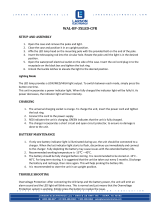
2 INSTALLATION AND OPERATION INSTRUCTIONS MN280080EN July 2018
Form 6 triple-single microprocessor-based pole-mount recloser control
ote:N Battery life is decreased at higher temperatures.
Dispose expired batteries in an environmentally responsible
manner. Consult local regulations for proper battery disposal.
Operation upon loss of AC power
The control is equipped with a 13 Amp-Hour 24 VDC lead
acid battery for operation upon loss of AC power. The control
maintains full operation from the battery for a period of
time— 24 hour maximum (20 °C)
In the event that the AC power has not returned within the
times listed above, the control will disconnect the battery
from the circuit.
ote:N The control continuously monitors the battery
voltage. To prevent battery damage, the control shuts
down automatically upon detection of low battery
voltage (below 22 VDC) for 60 seconds.
Control programming settings and parameters—including
event recorder—are stored in non-volatile memory and
retained upon loss of control power. The time/date clock will
continue to operate for approximately 30 days after loss of
control power.
IMPORTANT
If the the control shuts down due to low battery voltage
before AC power is restored, and the connected energized
recloser is CLOSED, it will only TRIP and LOCKOUT via front
panel pushbutton command.
A control that has shut down due to low battery voltage
before AC power is restored will have a blank LCD display
(no text message shown), and none of the LEDs will be
illuminated.
Phase B (Ø) is the factory default phase. Unless changed
by the user, the B PHASE VOLTAGE red LED illuminates
indicating AC is the operating power. If BØ (or the user-
indicated phase) loses AC power for more than ten seconds,
the ALARM red indicator LED will illuminate. The ALARM
log on the LCD Display will indicate NO AC PRESENT and
the CONTROL OK LED will not be illuminated.
The control clock may require resetting if the operating
power has been disconnected for more than thirty
days. Refer to Service Information S280-70-9 (ProView
4.X.X) or S280-70-23 (ProView 5.X.X) Form 6-TS
Microprocessor-Based Recloser Control Programming Guide
for information on setting the control clock.
Figure1. Form 6-TS recloser control is accessible from
both the front and back of the cabinet
Form 6 triple-single control description
Description
The Form 6 Triple-Single (Form 6-TS) control is designed for
use with these reclosers to provide protection, metering,
and automation of distribution feeders in substation and
line applications:
NOVA-TS Triple-Single recloser
NOVA STS Single-Tank, Triple-Single recloser
The Form 6-TS control operates the triple-single reclosers
representing phases A, B, and C.
ote:N Phase A, B, and C sequence positions are
independent of each other.
The Form 6-TS control uses three modes of operation.
All modes are configured through the ProView user
interface software.
Three-phase trip, Three-phase lockout (ganged)
Single-phase trip, Three-phase lockout
Single-phase trip, Single-phase lockout
The Form 6-TS recloser control includes extensive system
protection functionality, including phase, ground, and
negative sequence overcurrent protection, over/under
frequency, and voltage protection, directionality, sensitive
ground fault, and sync check.
Analysis tools include fault locating, event recording,
TCC Editor II, Idea Workbench, and oscillography functions,
including oscillography replay.
Metering functions include demand and instantaneous
current on a per-phase basis, instantaneous voltage and
power factor on a per-phase basis, and power (real, reactive,
apparent) on a per phase or total basis. Symmetrical
components for both voltage and current are displayed
along with kilowatt-hours for energy metering. Harmonics
from the 2nd to the 15th harmonic are also included.
The front panel LCD display is used to configure the
operating settings for the control. It is also used to display
metering, counter information, control parameters, alarms,
and provide diagnostic information.
Control parameters can also be programmed via a personal
computer connected to the control through the front panel
RS-232 port. Control programming, interrogation, and
operations are performed with Form 6 ProView interface
software on a personal computer.
The ProView interface program software includes additional
functions used to create and graphically display Time
Current Curves and provides the Idea Workbench for
configuring user-selected inputs and outputs, configurable
event and alarm data, and selectable communication points
for serial communication.
The control operates on 50 and 60 Hz systems.
The control can be configured, by the factory or by the
user, for a wide variety of applications. If user requirements
change, the control functions can be modified to meet the
new requirements.




















